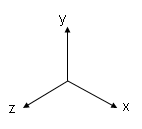How do you use the shell method to set up and evaluate the integral that gives the volume of the solid generated by revolving the plane region # y = x^3#, #y = 0#, #x = 2# rotated about the y axis?
1 Answer
Jul 16, 2015
Let
If you imagine what it means to use the shell method, what you have are the following components:
- Arc length
#2pi " rad"# (corresponding to the top and bottom faces that line up with the xz-plane) of a revolved 2D shape (the area under#x^3# between#x = 0# and#x = 2# and above#y = 0# )

- A function
#r(x)# that determines how the radius (center towards outer edge of outer "circle") of the curved portion of the revolved shell changes as the revolution occurs - A thickness
#x# that indicates the distance from the outside of each part of the revolved shell to where the empty space within it starts (in this case the empty space is above the#x^3# curve)
The "circumference" of this shape thus has the variable-radius function
At

